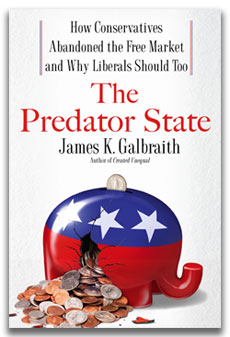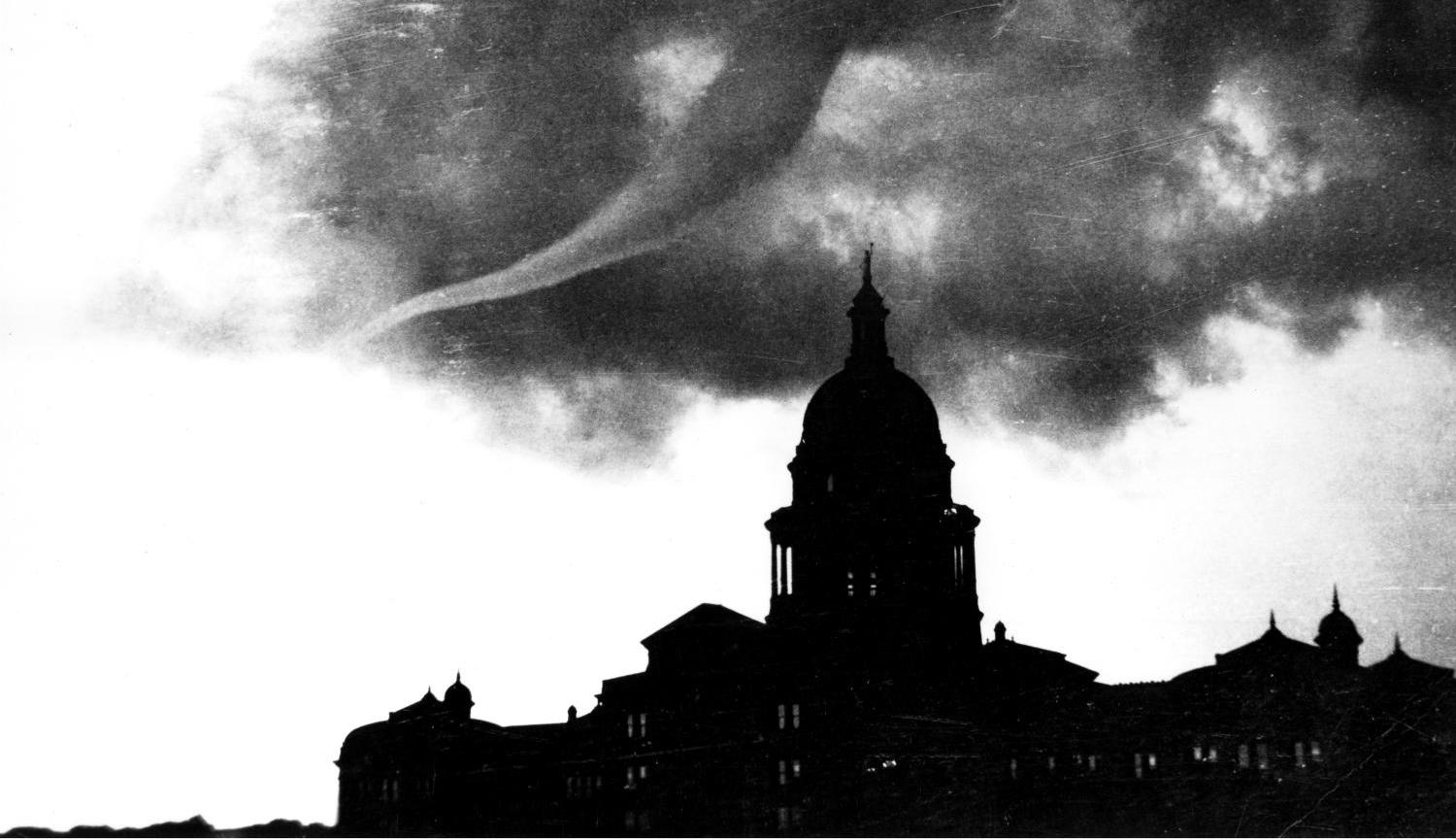Predatory Pachyderms
Government of Big Business, by Big Business, and for Big Business.
In his new book, The Predator State, James Galbraith charts the course of U.S. economic policy over the past 30 years, leading to the disastrous economics of the Bush presidency. Galbraith-an Observer contributing writer and holder of the Lloyd M. Bentsen Jr. Chair in Government/Business Relations at the LBJ School of Public Affairs at the University of Texas-shows how the ideology of the free market failed in application under Reagan but devolved into a mythology that still has many Democratic leaders mouthing its creed. Meanwhile, Republicans under Bush have moved on to a new vision of the corporate republic, in which public purpose and public resources become fodder for corporate profit. In the following excerpt from the book, Galbraith-son of the late economist, author, and ambassador, John Kenneth Galbraith-explains the current health-care and public- education debates as they play out in the “predator state.”
As power ebbed from the corporation in the late 1970s and 1980s and became vested, once again, in free-acting individuals, the basis for collaboration between comparatively progressive elements within business and a broadly progressive state tended to disappear. Instead, business leadership saw the possibility of something far more satisfactory from their point of view: complete control of the apparatus of the state. In particular, reactionary business leadership, in those sectors most affected by public regulation, saw this possibility and directed their lobbies-the K Street corridor-toward this goal. The Republican Party, notably in the House of Representatives under Newt Gingrich and later Tom DeLay, became the instrument of this form of corporate control. The administration, following the installation of George W. Bush, became little more than an alliance of representatives from the regulated sectors-mining, oil, media, pharmaceuticals, corporate agriculture-seeking to bring the regulatory system entirely to heel. And to this group was added another, overlapping to some degree, of equal importance: those who saw the economic activities of the government not in ideological terms but merely as opportunities for private profit on a continental scale. Jack Abramoff became, for a moment, the emblem of this class.
This is the Predator State. It is a coalition of relentless opponents of the regulatory framework on which public purpose depends, with enterprises whose major lines of business compete with or encroach on the principal public functions of the enduring New Deal. It is a coalition, in other words, that seeks to control the state partly in order to prevent the assertion of public purpose and partly to poach on the lines of activity that past public purpose has established. They are firms that have no intrinsic loyalty to any country. They operate as a rule on a transnational basis, and naturally come to view the goals and objectives of each society in which they work as just another set of business conditions, more or less inimical to the free pursuit of profit. They assuredly do not adopt any of society’s goals as their own, and that includes the goals that may be decided on, from time to time, by their country of origin, the United States. As an ideological matter, it is fair to say that the very concept of public purpose is alien to, and denied by, the leaders and the operatives of this coalition.

The Predator State is different from the New Industrial State, and yet it grows directly from the decline of the economic system my father, John Kenneth Galbraith, described in 1967. An economics of organizations and not of markets remains the only useful and pertinent way to describe it. Whereas in the New Industrial State the organization existed principally to master advanced technologies and complex manufacturing processes, in the Predator State the organization exists principally to master the state structure itself.
None of these enterprises has an interest in diminishing the size of the state, and this is what separates them from the principled conservatives. For without the state and its economic interventions, they would not themselves exist and could not enjoy the market power that they have come to wield. Their reason for being, rather, is to make money off the state-so long as they control it. And this requires the marriage of an economic and a political organization, which is what, in every single case, we actually observe.
The major battlegrounds of American domestic politics today emerge clearly once there is an understanding of the Predator State. They do not consist in the bipolar argument toward which so much thought and argument is directed-that of “government” versus “the market.” They do not for the most part consist in a perpetual war, as many are led by their training in economics to suppose, over whether the frontiers of the state should expand or contract. Rather, they assume that over time, the role of the state will gradually grow. At some deep level, everyone with a serious role in the policy debates agrees on this. The politics consists in a continuing battle over who gets cut in on the deal-and a corresponding argument over who gets cut out, and how, for there is profit in both cutting in and cutting out.
Thus, health care. The politics of health care in our time does not revolve around any grand conservative scheme to return medical care to the private sector; it is immediately apparent that without state funding, both the medical sector and the overall economy would collapse. (Without Medicare, the life savings of many elderly would be quickly depleted, and their life expectancies would also fall.) Nor does any serious politician propose drafting American doctors and transforming American hospitals into a replica of Britain’s National Health Service. Such a move, if it reduced American health care costs to British levels, would entail reducing total health care spending by nearly half. No less than complete privatization, that would also cause the medical sector to collapse and the economy to implode.Instead, the health care battle is waged in ways that tend to expand the system; the issue is on what terms and with how many concessions to existing predators. A major liberal goal is to extend the coverage of health insurance, particularly to children. The private insurance companies are opposed to this. Why? Because they stand to lose part of their existing clientele: better-off families with small children. Their economic function is uncomplicated: it consists in marketing to people who are relatively unlikely to need health care, while also not selling it to those most likely to get sick. Reform would be less profitable, and the health insurance companies have both profits to defend and resources (those very profits) to defend them with. The political battle is over nothing else.

Does the country benefit in any way from having such families with children under private insurance? Does it benefit from having any families under private insurance? No. To insure the whole population without screening would be economically efficient. It would save the resources now devoted to screening, and this would be cheaper from both an economic and an administrative point of view. Among other things, more resources could then go to actual health care. Harvard medical economists David Himmelstein and Steffie Woolhandler estimate the bureaucratic waste from private medical insurance to be around $350 billion per year-just under 2 percent of gross domestic product, and more than half the cost of the defense budget. They also point out that the popular liberal “solution” of employer mandates is ineffective, having been tried in numerous states without noticeable effect: “The ‘mandate model’ for reform rests on impeccable political logic: avoid challenging insurance firms’ stranglehold on health care. But it is economic nonsense. The reliance on private insurers makes universal coverage unaffordable.”
The struggle is epic precisely because it is zero sum. Here we see the immense power of the legitimating myth: by discussing it as though the issue had something to do with the efficiency of markets or the freedom of consumer choice, the defense of a functionless pool of profits can be made to seem a legitimate political position.
The expansion of Medicare to provide a drug benefit to senior citizens illustrates how the system works when a compromise is reached. In this case, a new benefit was delivered, meeting a need that had grown greater over the years as the composition of medical care shifted increasingly toward chemical and pharmaceutical therapies. But the program was done in such a way as to make payments to drug companies as large as possible. Notoriously, the U.S. government was prohibited by law from negotiating bulk discounts on the drugs purchased for the program-discounts routinely exacted by other government agencies, such as the Veterans Administration. (Before the benefit was enacted, there had been developing a minor industry of exports and imports, as U.S.-made drugs were shipped to Canada, sold at the lower prices negotiated by Canadian public authorities, and reimported to the United States. Needless to say, although this arbitrage reflected one of the better moments for free trade, it did not win favor with the ostensible free traders then in power.) The Medicare drug benefit thus helped to ensure that a monopoly price on pharmaceuticals would be paid, while shifting the burden of paying it, in part, to the general taxpayer.
Schools have been a bastion of American public effort for nearly two centuries, and they are today on the front lines of the Predator State. Early in the Bush administration, policy toward the public schools took the form of advancing voucherization, a system that would have allowed a partial state subsidy for alternative schooling, encouraging middle-class parents to take their children to the private sector. (Such a system exists in Chile, having been created by the military regime of Augusto Pinochet.) The not very effectively disguised purpose was to get public funding into the hands of for-profit and religious entities, which would then set up voucher-eligible schools. The clients of this new system would have been middle-class parents unhappy with the public schools, able to spend something from their own pockets on their own children’s schooling, but not willing to pay for private schools on top of the taxes that support their local school board. Vouchers would in effect permit those parents to pull their property tax payments from the public system.
The idea of vouchers, whose origins go back to Milton Friedman himself, once again rested on a rhetoric of markets, competition, freedom, and “school choice.” But by and large, the public has not been persuaded: vouchers enjoy little public support, and the proportion of American children attending public school has so far not materially declined. It developed that even most middle-class Americans were not sufficiently unhappy with the public schools their children were actually in to risk confiding their children to schools not yet in existence, whether run by for-profit educational corporations or by churches. Nor were they willing, as a group, to desert the social and community networks that in many American communities are organized around the public school systems.
Taking stock, the Bush team switched its emphasis to No Child Left Behind, a program that expanded federal spending on public schools while imposing an intense testing regimen on them. Forms of predatory free enterprise in which certain Bush family members participated (selling test preparation programs to public school systems) quickly emerged. But the larger effect of NCLB was to foment middle-class discontent with public schools, for three reasons. First, the testing regimes cut deeply into the flexibility and creativity in the classroom, discouraging creative professionals from becoming teachers and demoralizing many who remained. Second, the emphasis on teaching to the test undermined educators’ attention to and the resources available for untestable programs, including art, music, and athletics. And third, the harsh evaluation regime behind the tests themselves worked to label, and therefore to stigmatize, certain schools as failing. From the standpoint of both parents and teachers, schools that were judged to be failing by the test results sometimes were not. But this was beside the point: a bad test result could have serious, even catastrophic effects on reputation and funding, precipitating middle-class flight from the system. In this way, NCLB would feed the demand for vouchers later on.
From The Predator State by James K. Galbraith. Copyright © 2008 by James Galbraith. Reprinted by permission of Free Press, a Division of Simon & Schuster, Inc.


